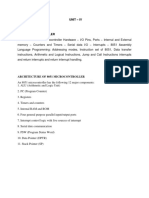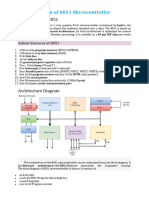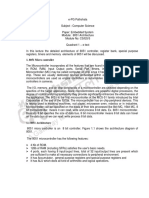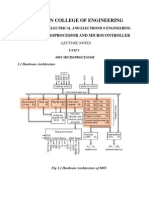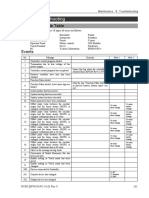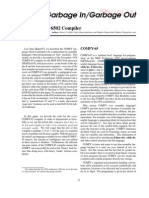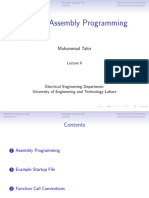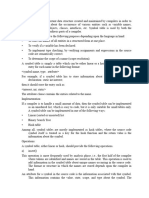AVR CPUCore:
Block Diagram of A VR MCU Architecture:
(AVR Microcontroller is "Advanced Virtunl RISC" and MCU is the short tem of the Microcontroallen)
Data Bus B-bil
rop Blalu
Flash
Counter nd1Control
FrOgram
Momoy
2 x
ntorrupt
elio Gener
Purposo
Roginlrors
SPT
n
Instruction Walchdo
Decodor Timer
ALU Analog
Control Lines Compardtor
VO Module1
ala VO Module 2
pAM
VO Module n
w
EEPROM
VOLines
T o maximize the performance and parallelism, the AVR uses Harvard architecture (separate
memories and buses for program and data) with single level pipelining.
instruction is being executed, the next instruction is pre-
Single level pipelining: While one
etched irom the Program This concept enables instructions to be executed in
memory.
every clock cycle.
The Program memory is In-System Reprogrammable Flash memory.
There are 32, 8-bit GPRs are available R0-R31. 6 among this 32 registers used as three 16-
bit indirect address register pointers for Data Space addressing-enabling efficient address
calculations.
X,Y,Z: Indirect Address Register (X=R27:R26, Y=R29:R28 and Z=R31:R30).
One of these address pointers can also be used as an address pointer for look up tables in
Flash Program memory.
Fast-access Register File contains 32 x 8-bit general purpOse working registers with a single
clock cycle access time. This allows single-cycle Arithmetic Logic Unit (ALU) operation.
Every Program memory address contains a l6- or 32-bit instruction.
sections have dedicated
divided in two sections; both
space is
Program Flash memory
read/write protection.
Lock Bits for write and
section
o Boot program
o Application program section into the Application
writes
Flash memory
instruction:
SPM (Store Program Memory)) a page in the
SPM can be used to erase
reside in the Boot program section.
Section must write a page in the Program memory (that
is
already erased),
and to set
Togram memory, to
Boot Loader Lock bitsS.
the
general data Static RAM (SRAM), and consequently
is effcctively allocated in the
Stack size the usage of the SRAM.
Stack is limited
only the total SRAM size and
by
All must
Stack Pointer (SP) is read/write accessible in the V0 space.
user programs
initialize the SP in the reset routine (before subroutines or interrupts are executea.
stored on
During intemupts and subroutine calls, the return address Program Counter (PC) 15
the Stack.
A flexible interrupt module has its control registers in the /0 space with an additional
global interrupt enable bit in the Status Register.
All interTupts have a separate Intermupt Vector in the Interrupt Vector table. The intemupts
have priority in accordance with their Interrupt Vector position.
T h e lower the Interrupt Vector address, the
The O
higher the priority.
memory space contains 64 addresses for CPU peripheral functions as Control
Registers, SPI, and other 1/O functions,
SArithmetic Logic Unit - ALU: The high-performance AVR ALU operates in direct
connection with all the 32 general purpose working registers. Within a single clock cycle,
arithmetic operations between general
purpose registers or between a register and an immediate
are executed. The ALU
operations are divIded into three main categories arithmetic, logical,
and bit-functions. Some
implementations ot the architecture also provide a powertul multiplier
Supporting both signed/unsigned multiplication and fractional format. After an arithmetic
operation, the Status Register is also updated to reflect informmation about the result of the
operation.
Status Register:
I t contains information about the result of the most recently executed arithmetic instruction.
This information can be used for altering program flow in order to perform conditional
operations
NOTE: N's value is updated after all ALU operations, as specified in the Instruction Set
Reference
This register is not automatically stored when entering an interrupt routine and restored when
returning from an interrupt. This must be handled by software.
B 7
L C sREC
REG
Keaowe RUW
File:
General Purpose Register input/output
and flexibility, the following
I n order to achieve the required performance
schemes are supported by
the Register File:
and one 8-bit result input.
One 8-bit output operand
and one 8-bit result input.
Two 8-bit output operands
and result
one 16-bit input.
Two 8-bit output operands
and one 16-bit result input. in the C P .
One 16-bit output operand working registers
ofthe 32 general
purpose
the structure
below to all registers,
Figure showninstructions operating on the Register File have direct
access
Most of the
the
and single cycle
instructions. them directly into
are
a Data memory
address, mapping
is also assigned
Each register user Data Space. only work in
first 32 locations of the accessible. R16-R31 registers
RO-RI5 registers are
not immediately
immediate addressing mode.
Oxio
xmuur lew B
Onl
The X-register, Y register and Z-register:
added functions to their general purpose usage. These
R26..R3I have some
The registers DataSpace. The three
16-bit address pointes for
indirect addressing of the
registers are Z.
indirect address registers X, Y and
KH
15
7
KAegistar R26 (0x1A)
R27 (Ox1B)
15 YH
Y-Ogslor
7
R29 (01D) R28 (OxTC)
Z-1ogisler 7
R31 (0x 1F) R30 (01E)
Bit Name of the Description of the Bit
Bit
T h e 1-bit must be set for the interrupts to be enabled. The
1: Global
individual interrupt enable control is then performed in separate
Interrupt
Enable control registers.
I f 1-bit is cleared, none of the interrupts are enabled independent
of the individual interrupt enable settings.
has and
1-bit is cleared by after
hardware an interrupt occurred,
is set by the RETI instruction to enable subsequent interrupts.
I-bit can also be set and cleared by the application with the
SEI and CLI instructions.
6
T: Bit Copy The Bit Copy instructions BLD (Bit LoaD) and BST (Bit
Storage STore) the T-bit
use destination for the operated
as source or
bit
A bit from a register can be copied into T by the BST
A bit in T can be copied into a bit in a register by the BLD
H: Half Carry This flag H indicates a Halff Carry in some arithmetic operations.
Flag Carry at nibble (An auxiliary flag). It is useful in BCD arithmetic.
Ex:
S: Sign Bit S= N V (Ex-or between Negative FlagN and Two's
Complement Overflow Flag V)
V: Two's The Two's Complement Overflow Flag V supports two's
Complement complement arithmetic.
Overflow
Flag
N: Negative The Negative Flag N indicates a negative result in an arithmetic or
Flag Togic operation.
N=1; ifMSB of result is l; else N =0
Z: Zero Flag The Zero Flag Z indicates a zero result in an arithmetie or logic
operation.
Z= 1; if result =
00h; ese Z =
0
0 C: Carry Flag The Carry Flag C indicates a Carry in an arithmetie or logic
operation





